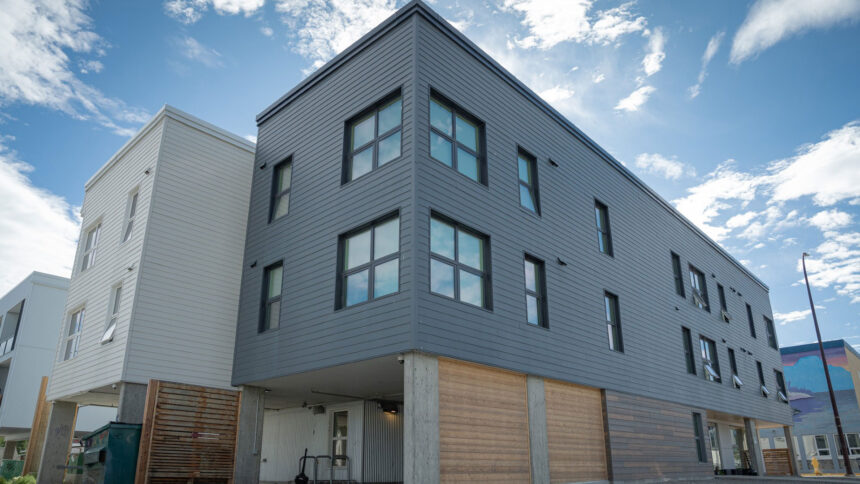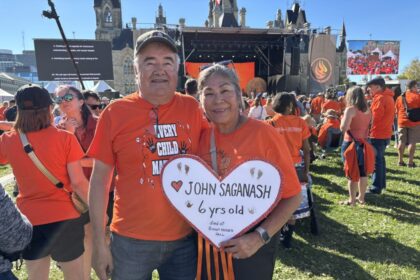A supportive housing building in downtown Whitehorse is now under new management, replacing a previous operator which has faced public scrutiny in recent years because of overdose deaths at its facilities. The Yukon government announced on July 23 that the Safe at Home Society, a NGO focused on combatting homelessness, began operating a supportive housing program at the building on July 1. The Housing First program at the building previously operated by Connective, a non-profit based in the Yukon and British Columbia. “As an organization, we’re really invested in, you know, building out the continuum of supports available to individuals,” said Kate Meechan, Safe at Home’s executive director. The 16-unit government-owned building was opened in 2019 as the territory’s first Housing First residence. Housing First focuses on providing vulnerable people with immediate access to housing without housing readiness requirements like sobriety or treatment, while also providing them with supports. Connective, in partnership with the Council of Yukon First Nations (CYFN), took over operation of the Housing First program from the government in 2021. The change in operators from Connective to Safe at Home follows mounting public opposition against Connective. Connective, which also operates the Whitehorse emergency shelter, another 20-unit Housing First program located above the shelter, as well as a reintegration program at the Whitehorse correctional facility, has faced criticism in recent years for its role in overdose deaths that took place on its watch. Last year, an inquest that examined the deaths of four First Nations women who died at the shelter resulted in the government launching an independent review of Connective’s programming. While the review found the program was well suited to provide low barrier housing, it also found it faced issues with things like tenancy legislation, guest management concerns and tenants resisting wellness checks. Jamie McAllister, vice-president of the Yukon Housing Corporation, said the decision to go with a new operator had nothing to do with Connective, but rather with the Housing First model. “That review gave us some insights into some of the challenges of that model,” he said. McAllister said at the same time, the government’s funding agreement with Connective was coming to an end, leading it to reach out to the wider community for alternatives. He said an evaluation panel ultimately landed on Safe at Home’s proposal. The organization currently operates a separate 17-unit supportive housing program across from the shelter and plans to open a 67-unit building next spring. “Moving to that kind of operation and that kind of model is really going to result in more positive outcomes, we think, for residents,” McAllister said. Different housing models Meechan said while the supportive housing model is similar to Housing First, the fundamental difference is that it doesn’t operate under the constraints of tenancy legislation. “(Housing First) was set up so that residents’ leases fell under the Residential Landlord and Tenant Act, which meant that, of course, Connective had to be following all of the various sort of protocols around navigating that legislation as they were trying to provide supports,” she said. “I don’t think that has anything to do with Connective, but more just that the way the program was set up.” Meechan said Safe at Home’s housing model is considered transitional housing, which doesn’t fall under the act. Instead, residents sign an agreement for the program outlining its terms, rules and responsibilities, allowing the program to enforce more oversight when it comes to areas like safety. Meechan said while there’s no end to tenancies at the building, the organization is actively supporting residents in becoming independent. “There’s some similarities in the model, and then some differences,” Meechan said. “We’re just a different organization that brings a different approach.” She noted the response so far from residents – all of whom agreed to the new program – has been positive. “People are noticing that things are quieter, that at times they feel safer, that our staff team is approachable. We’ve also had some positive feedback from surrounding neighbors who have noticed that there isn’t as much foot traffic at all hours of the night, those sorts of things, that the surrounding space is looking a little bit more like a community, a little bit cleaner than it might have been before,” she said. “That’s not me pointing fingers at Connective – that’s just people’s observations.” Meechan said her organization plans to offer more activities and programming options at the building in and will install overdose prevention alarms in each unit next week. She said another big focus right now is relationship building. “Creating that trust to have open dialog about safety and substance use is really our approach, for sure,” she said. Anne Aram, director of homelessness and housing services, said the government is “very happy” with what it’s seen. “With guest management, with increased intensive life skills, what we’re hoping is people will not only feel part of a community – they will be safer in the long run,” she said. When asked if there could be a change of operators for the Housing First program above the shelter, Aram said it is something on the government’s radar. “There have been conversations, we have not landed on anything yet,” she said. “Right now, we are working on negotiating agreements, we are looking at how this moves forward and we’re seeing how it goes at (the supportive housing building).” Former operator disappointed Chantal Genier, Connective’s director of Yukon operations and engagement, said in a statement that its submission to the evaluation panel built on its learnings of the “challenges inherent in local service provision” and that the Housing First program “made a lasting impact in the lives of many residents who called the program home.” “Ultimately, the evaluation panel chose to proceed in a different direction. Although we knew this was a possible outcome, the news was still difficult to receive,” she said. Read More: ‘We have room for improvement’: Management testifies at Whitehorse inquest Genier said Connective is nonetheless proud of the work it achieved with the program. “Our focus there has always been on creating safe, stable, and inclusive housing, and we’re confident that this new model will continue to build on that foundation,” she said. Genier said with the change of operators now complete, the organization has fully turned its attention on its other programming and remains “committed to supporting community wellbeing across the territory.” CYFN confirmed in an email to APTN News that it no longer has any role with the building. Continue Reading
Yukon government hands control of supportive housing building to new organization

Leave a Comment










